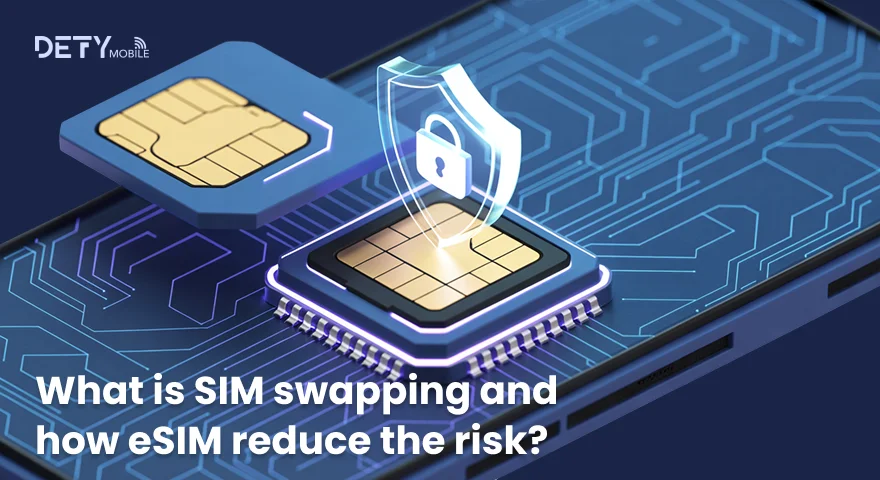With the rise in technical advancements, people who are working with negative means of earning have also become stronger. There is a huge chance that your number can be hijacked easily. This is an alarming and dangerous situation.
You wake up and check your phone. It shows "No SIM." Soon after, you can't access your email, bank, or social media accounts.
You didn’t lose your phone. You lost your identity to a SIM swap scam.
Reading this blog is a must for that moment before it happens. We'll help you understand how eSIM technology isn't just about convenience; it's a powerful step toward digital security.
And if you're a traveller, remote worker, or someone who's ever relied on two-factor authentication, you are in the right place!
What Is a SIM Swapping Scam?
SIM swapping, also known as SIM hijacking, is when a criminal convinces your mobile carrier to switch your phone number to a new SIM, one they control.
Once they’ve taken over your number, they can intercept texts, calls, and most importantly, two-factor codes to access your personal accounts.
This isn’t a hacker-in-a-basement story. It happens in real life. Every day.
How Does SIM Swapping Actually Work?
It usually begins with social engineering. Fraudsters gather your personal info (sometimes from data leaks or phishing scams), then contact your mobile network carrier pretending to be you. Once they succeed, your number is assigned to a new SIM.
You lose service, and the attacker gains access to your accounts.
Or modern means are the ads and links shared with you from unknown sources. By clicking those links, you eventually become the bait.
It's fast. It's silent. And by the time you notice, the damage may already be done.
What Makes SIM Swapping So Dangerous?
In case you are not aware, what a SIM Swap can do to you, or how much harm it will cause you, here is what makes you understand this:
Bank Fraud: With access to your phone number, scammers can intercept OTPs from banks or payment platforms.
Identity Theft: Your accounts, including Gmail, WhatsApp, and Instagram, or places where you have mentioned your number, are at risk.
Lockouts: Many platforms rely on SMS to recover accounts. Once locked out, recovery is time-consuming and painful.
Travel Complications: Imagine this happening mid-trip, far from home, with no access to local support.
Why Are SIM Swaps Increasing?
Traditional SIM cards can be removed, replaced, or cloned. This makes them the weakest link in mobile security. And with the rise of cryptocurrency, online banking, and remote work, a hijacked number can unlock a digital goldmine.
Means that what you are thinking is safe, it is not. Being a Physical SIM user, you are closer to getting swapped.
How Do I Know If I’ve Been SIM Swapped?
Losing all you have is an option of knowing, but if you want to check now, the following are some common signs:
- Sudden loss of mobile service.
- Notifications for account logins you didn’t authorize.
- Locked out of your email or financial accounts.
- SMS-based 2FA stops working.
If even one of these happens, act fast.
What Should I Do If I’ve Been SIM Swapped?
Now, if you find out that you are losing all of your precious assets one by one or smell any fishy activity, you need to do the following:
- Contact Your Carrier Immediately – Report the attack and ask them to freeze any changes.
- Secure Your Accounts – Change passwords, remove phone-based 2FA, and use authenticator apps.
- Inform Your Bank and Services – Flag unusual activity.
- Report the Incident – Notify your country’s cybercrime authorities
So, How Can eSIMs Reduce the Risk of SIM Swapping?
Unlike physical SIM cards, eSIMs are built into your phone. They can’t be stolen, removed, or swapped physically because they are a digital asset. Every profile switch or activation requires internal verification, making it harder for scammers to impersonate you.
Here’s how eSIM adds absolute protection:
- Remote-only activation: There’s no chip to remove or replace. Changes must happen digitally and are harder to fake.
- Stronger identity verification: Carriers often require more authentication before making eSIM changes. This keeps you save from data breaches and SIM swap attacks.
- More control for the user: You manage your eSIM directly from your phone, not a store kiosk or call centre.
- Travelers benefit more: With remote activation, you're not at the mercy of in-store fraud or risky SIM swaps in unfamiliar countries.
Can eSIMs Be Hacked Too?
While nothing is bulletproof, eSIMs significantly reduce the surface area of attack. With no removable card to physically steal and stricter activation requirements, SIM swap fraud becomes harder to execute.
But like all things, your security depends on layers. Use strong passwords. Avoid phishing links. And continuously monitor unusual account activity.
eSIMs and Travel: Extra Layer of Safety on the Go
If you're traveling abroad, switching to local SIM cards often means trusting unfamiliar shops or public Wi-Fi. With eSIMs, you're in complete control. Buy, activate, and switch plans without handling a physical SIM.
Defy Mobile eSIM lets you stay connected across the world securely, with plans designed for global coverage, managed right from your phone.
Conclusion: Is eSIM the Future of Mobile Security?
Absolutely! And it’s already here.
While eSIM technology wasn’t designed solely for security, its structure naturally closes many of the loopholes SIM swappers exploit. When paired with good digital habits, it becomes a powerful barrier between you and identity theft.
If you care about keeping your number and your identity safe, switching to an eSIM is one of the smartest decisions you can make.
So, make sure to buy a Defy Mobile eSIM next time when you travel. We are under the data credibility of every user and have applied the best security standards and protocols to offer you seamless connectivity services.
FAQs
Is SIM swapping still a threat in 2025?
Yes, and it's evolving. Attackers now use personal data leaks and social engineering to hijack phone numbers.
Can someone still SIM swap me if I use eSIM?
It’s much harder. eSIMs don’t rely on physical cards and require more secure steps to transfer.
Do banks recognize eSIM as safer?
Many institutions now recommend eSIM for better 2FA protection, especially while traveling.
Can I switch to eSIM while abroad?
Yes, with providers like Defy Mobile, you can install and activate eSIMs from anywhere, anytime.
Do I still need an authenticator app if I have an eSIM?
Yes. Use it as an extra layer of protection with your eSIM. The Defy Mobile eSIM App lets you create your profile for added security. You will have your personal dashboard for monitoring everything.

